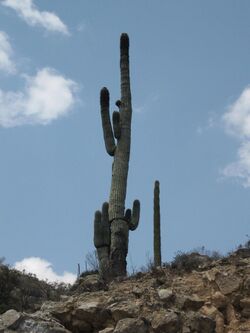Neobuxbaumia macrocephala
Topic: Biology
 From HandWiki - Reading time: 3 min
From HandWiki - Reading time: 3 min
| Neobuxbaumia macrocephala | |
|---|---|

| |
| Scientific classification | |
| Kingdom: | Plantae |
| Clade: | Tracheophytes |
| Clade: | Angiosperms |
| Clade: | Eudicots |
| Order: | Caryophyllales |
| Family: | Cactaceae |
| Subfamily: | Cactoideae |
| Genus: | Neobuxbaumia |
| Species: | N. macrocephala
|
| Binomial name | |
| Neobuxbaumia macrocephala (F.A.C.Weber ex K.Schum.) E.Y.Dawson
| |
| Synonyms | |
|
Cephalocereus macrocephalus F.A.C.Weber ex K.Schum. | |
Neobuxbaumia macrocephala is a long-lived columnar cactus
Distribution
It is endemic to the Tehuacán-Cuicatlán Valley in central Mexico. Within this region the species may be found on calcareous soil in xerophytic shrublands and tropical dry forest at an altitude of 1700 m above sea level.[1][2][3]
Description
It is a branched columnar cactus that reaches between 7 and 15 m in height. The number of branches in an adult plant may vary from one to 10. Plants bear a reddish cephalium at the tip of each branch from which purple-red flowers emerge between May and June, during the end of the dry season. The species is hermaphroditic and its flowers are mainly nocturnal, opening at sunset (1900 h) and closing in the morning (1000 h). The bats Choeronycteris mexicana Tschudi, Leptonycteris curasoae Miller, and Leptonycteris nivalis (Saussure) are the main pollinators that promote seed production. Fruits ripen from June to August and are consumed by bats and bird species that probably act as seed dispersers. Neobuxbaumia macrocephala occurs at densities between 130 and 200 individuals/ha. Seed germination and seedling establishment occurs mostly beneath the canopies of several species of trees and shrubs, such as Pseudosmodingium multifolium, Lippia graveolens, Gochnatia hypoleuca, and Aeschynomene compacta. First reproduction occurs when plants are around 2 m tall.
Ecology
The microbiota associated to this species include methylotrophic bacteria, see Methylotroph, both in its stem surface and inside the plant.[4] Their function might be related to the growth promotion of N. macrocephala, but it has not been demonstrated yet.
Conservation status
CITES Appendix II - Trade controlled to avoid use incompatible with species survival.
Synonyms
Carnegiea macrocephala (F.A.C. Weber ex K. Schum.) P.V. Heath Calyx 2(3): 109. 1992. (Calyx)
Cereus macrocephalus (F.A.C. Weber ex K. Schum.) A. Berger Annual Report of the Missouri Botanical Garden 16: 62. 1905. (Rep. (Annual) Missouri Bot. Gard.)
Cereus melocactus (F.A.C. Weber ex K. Schum.) A. Berger Annual Report of the Missouri Botanical Garden 16: 62. 1905. (Rep. (Annual) Missouri Bot. Gard.)
References
- ↑ Miquelajauregui, Y.; Valverde, T. (2010). "Survival and early growth of two congeneric cacti that differ in their level of rarity". Journal of Arid Environments 74 (12): 1624–1631. doi:10.1016/j.jaridenv.2010.07.006.
- ↑ Ruedas, M.; Valverde, T.; Zavala-Hurtado, J.A (2006). "Analysis of the factors that affect the distribution and abundance of three Neobuxbaumia species (Cactaceae) that differ in their degree of rarity". Acta Oecologica 29 (2): 155–164. doi:10.1016/j.actao.2005.09.002.
- ↑ Valiente-Banuet, A.; Rojas-Martínez, A.; Coro-Arizmendi, M. del; Dávila, P. (1997). "Pollination biology of two columnar cacti (Neobuxbaumia mezcalaensis and Neobuxbaumia macrocephala) in Tehuacan Valley, Central Mexico". American Journal of Botany 84 (4): 452–455. doi:10.2307/2446020.
- ↑ Bustillos-Cristales, M.R.; Corona-Gutierrez, I.; Castañeda-Lucio, M.; Águila-Zempoaltécatl, C.; Seynos-García, E.; Hernández-Lucas, I.; Muñoz-Rojas, J.; Medina-Aparicio, L. et al. (2017). "Culturable facultative methylotrophic bacteria from the cactus Neobuxbaumia macrocephala possess the locus xoxF and consume methanol in the presence of Ce3+ and Ca2+". Microbes and Environments 32 (3): 244–251. doi:10.1264/jsme2.ME17070. ISSN 1347-4405. PMID 28855445.
Bibliography
Godínez-Alvarez, H., and A. Valiente-Banuet. 2004. Demography of the columnar cactus Neobuxbaumia macrocephala: a comparative approach using population projection matrices. Plant Ecology 174: 109-118.
Esparza-Olguín, L., T. Valverde, and E. Vilchis-Anaya. 2002. Demographic analysis of a rare columnar cactus (Neobuxbaumia macrocephala) in the Tehuacán Valley, México. Biological Conservation 103: 349-359.
External links
Wikidata ☰ Q1977451 entry
 KSF
KSF